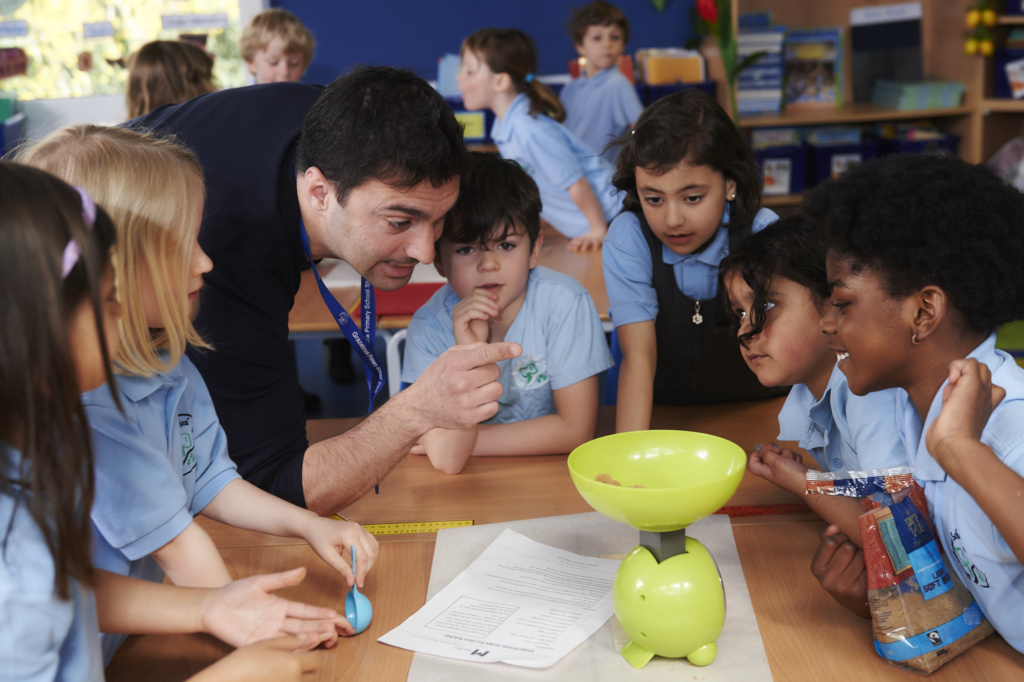
The five-year old boy smiles confidently at his class. “Because I know that double four is eight, and I know that a square has four sides, I know that two squares will have eight sides altogether”. It’s just a normal day for the class, and reasoning like this has become an expected part of Year 1 maths lessons.
A huge improvement in children’s language and reasoning is often the first significant impact reported by schools who join the Mathematics Mastery partnership. Many of our partner schools have above-average numbers of children with special educational needs and English as an additional language. Maths lessons have often been previously regarded as an escape or retreat from the need to read, write, talk and hear English. Surely maths lessons are for numbers, not words?!
As Kevin Durkin and Beatrice Shire, author of the influential book Language in Mathematics Education, wrote in the early 1990s: “Mathematics education begins and proceeds in language, it advances and stumbles because of language, and its outcomes are often assessed in language.”
There is of course a symbiotic relationship between a pupil’s conceptual understanding in maths and their confident use of mathematical language to demonstrate that understanding. Conceptual understanding and proficiency in mathematical language progress together, hand-in-hand.
As a member of the team that drafted the National Curriculum for mathematics, I’m delighted that the final version includes such a strong statement on spoken language.
“The quality and variety of language that pupils hear and speak are key factors in developing their mathematical vocabulary and presenting a mathematical justification, argument or proof. They must be assisted in making their thinking clear to themselves as well as others and teachers should ensure that pupils build secure foundations by using discussion to probe and remedy their misconceptions.”
But as a busy practitioner, I’m also aware of the pressures and constraints that can prevent this kind of lofty statement becoming a reality in the classroom.
That’s why I founded Mathematics Mastery, which is devoted to helping teachers plan and teach great maths lessons. Joining gives all their teachers access to a wealth of blended (face-to-face and online) maths-specific professional development.
Grounded In A Collaborative Curriculum
Importantly, this training is all grounded in our collaborative curriculum – the curriculum overview for the year is supported by units, each fully resourced with tasks for children, examples of what children should say and do, and interactive whiteboard slides.
One advantage of this is that teachers can use their valuable time for the things that matter – instead of typing lesson objectives and questions onto slides, they can really own and plan the lesson, thinking through what they and the children will say and do.
Developing pupils’ language is an important feature of the Mathematics Mastery approach. Our professional development and classroom resources support teachers to develop pupils’ mathematical communication through:
- sharing the key vocabulary at the beginning of every lesson, and insisting on its use throughout;
- modelling clear sentence structures and expecting children to respond using a full sentence;
- ‘Talk Task’ activities in every lesson, allowing children to discuss their thinking and reasoning of the concepts being presented;
- Further opportunities to assess understanding through children’s explanations.
Our expertly-crafted curriculum uses a carefully sequenced, structured approach to introducing and reinforcing mathematical vocabulary throughout maths lessons, so pupils have the opportunity to work with word problems from the beginning of their learning. Pupils revisit mathematical language from previous years and explore the concepts in greater depth. There are opportunities for pupils to clarify vocabulary and explore activities that develop an understanding of the different concepts.
We provide teachers with all the resources they need to include a ‘Talk Task’ in every lesson. We design ‘Talk Tasks’ to provide opportunities for pupils to use mathematical language and to develop their comprehension. The main focus here is on the children working together in pairs – taking turns and listening – and talking in full sentences about maths.
Deep Understanding
Better use of language and communication gives children a level of confidence that is born through being able to fully understand and make up their own sentences. Their deep understanding of constructing sentences soon begins to show through. Including a talk task in every maths lesson helps to shift children’s and teacher’s conception of what it means to learn maths. One 6 year-old told us “My favourite part of maths lessons are talk tasks because you get a chance to work with someone and if you get something wrong they can help you.”
As one teacher put it, “The emphasis on language is particularly helpful. Previously, pupils would have been able to complete the maths but I think they have better conceptual understanding from this approach. It really stands out to me for example with place value work, when they can explain what’s going on.”
We’ve learnt a lot about how to develop pupils’ mathematical language and communication.

Top tips for developing pupils’ mathematical language and communication.
Tip #1: Opportunities to talk in every lesson
There should be opportunity in every maths lesson for pupils to get talking. We use Talk Tasks. Pupils have five to 10 minutes in every lesson to explicitly practise using the new language that they have learned in the day’s maths lesson, either in pairs or small groups. The opportunity to talk about what they have learned helps them become aware of what they now know, which enables them to clarify, explore, consolidate and reorganise their new knowledge. Pupils will respond differently. Less confident children often struggle to discuss mathematical ideas while more confident children might feel that they can get “the answer” on their own. All of them, however, will benefit from mathematical talk, as they practise using words and sentence structures that embed a more complete understanding of mathematical concepts. We recommend putting children in mixed-attainment pairs for this kind of activity as this helps everyone to participate.
Tip #2: Make sure everyone feels listened to
This is easier said than done but a selection of ground rules and certain types of support can level the playing field for everyone to get talking on equal terms. We insist that all students speak in full sentences, often giving pupils scaffold phrases to help them begin their sentences. In a year 2 classroom, a simple exchange between teacher and pupil might go something like this:
- Teacher: What is five multiplied by six?
- Pupil: Thirty.
- Teacher: Five multiplied by…
- Pupil: Five multiplied by six is equal to 30.
The insistence on full sentences, with support to get students started, creates a classroom ethos that empowers all pupils to talk meaningfully which, in turn, helps all pupils feel heard.
Tip #3: Teach mathematical language meaningfully
Mathematics does have a precise formal language which is distinct from our everyday language. It is important to know what these words mean when teaching maths. For example, in maths, a “product” is not always something you make or buy and a “sum” is more specific than it seems. Insisting on the use of “star words” – key words that underpin that day’s learning– helps lead to the correct use of precise vocabulary.
It is also important, however, to let pupils connect their own informal use of language to the more formal mathematics register. Once the words and scaffold phrases have been introduced, pupils should use exploratory, often informal, talk in paired activities to get to grips with what they are learning. Teachers should listen to help their pupils refine their own definitions to avoid overlaying “correct” explanations and definitions which can leave students with a disconnected, shallow understanding.
Tip #4: Listen openly to your pupils
We can all find ourselves listening for the answers we expect to hear rather than really listening to answers. When we listen, however, we deepen our understanding of where the pupil is coming from. A teacher can only tackle misconceptions and help to build understanding if they really listen and resist jumping on answers as either “right” or “wrong”. It is a teacher’s job to pick out the maths from the jumbled words a pupil says and by doing this start to unpick misconceptions. Tip #5: Use words to make connections Learners extend and deepen their understanding when they find that the words they understand in one context also apply in another context. The words become the bridge, connecting mathematical ideas. For example, saying 0.8 out loud as “eight-tenths” helps learners to see that 0.8 can be represented as a fraction. A structured approach to language for mathematics helps to introduce words in a coherent order to aid cumulative mastery of vocabulary and a deeper understanding of maths itself.
Helen Drury is founder and CEO of the Mathematics Mastery Partnership
Register for free
No Credit Card required
- Register for free
- Free TeachingTimes Report every month